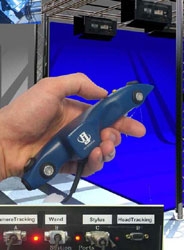 |
Abstract: The Helical Keyboard: Perspectives for Spatial Auditory Displays and Visual Music
Jens Herder and Michael Cohen. The Helical Keyboard: Perspectives for Spatial Auditory Displays and Visual Music, Journal of New Music Research, Swets & Zeitlinger, Vol. 31, No. 3, pp. 269-281, 2002.
Auditory displays with the ability to dynamically spatialize
virtual sound sources under real-time conditions enable
advanced applications for art and music. A listener can be
deeply immersed while interacting and participating in the
experience. We review some of those applications while
focusing on the Helical Keyboard project and discussing the
required technology.
Inspired by the cyclical nature of octaves and helical
structure of a scale, a model of a piano-style keyboard was
prepared, which was then geometrically warped into a helicoidal
configuration, one octave/revolution, pitch mapped to
height and chroma. It can be driven by MIDI events, real-time
or sequenced, which stream is both synthesized and spatialized
by a spatial sound display. The sound of the respective
notes is spatialized with respect to sinks, avatars of the
human user, by default in the tube of the helix. Alternative
coloring schemes can be applied, including a color map compatible
with chromastereoptic eyewear. The graphical display
animates polygons, interpolating between the notes of a
chord across the tube of the helix. Recognition of simple
chords allows directionalization of all the notes of a major
triad from the position of its musical root.
The system is designed to allow, for instance, separate
audition of harmony and melody, commonly played by the
left and right hands, respectively, on a normal keyboard.
Perhaps the most exotic feature of the interface is the ability
to fork ones presence, replicating subject instead of object
by installing multiple sinks at arbitrary places around a
virtual scene so that, for example, harmony and melody can
be separately spatialized, using two heads to normalize the
octave; such a technique effectively doubles the helix from
the perspective of a single listener. Rather than a symmetric
arrangement of the individual helices, they are perceptually
superimposed in-phase, co-extensively, so that corresponding
notes in different registers are at the same azimuth.
Keywords:
3D audio, virtual reality, computer music, spatialization, spatial media, visual music
|
 |
